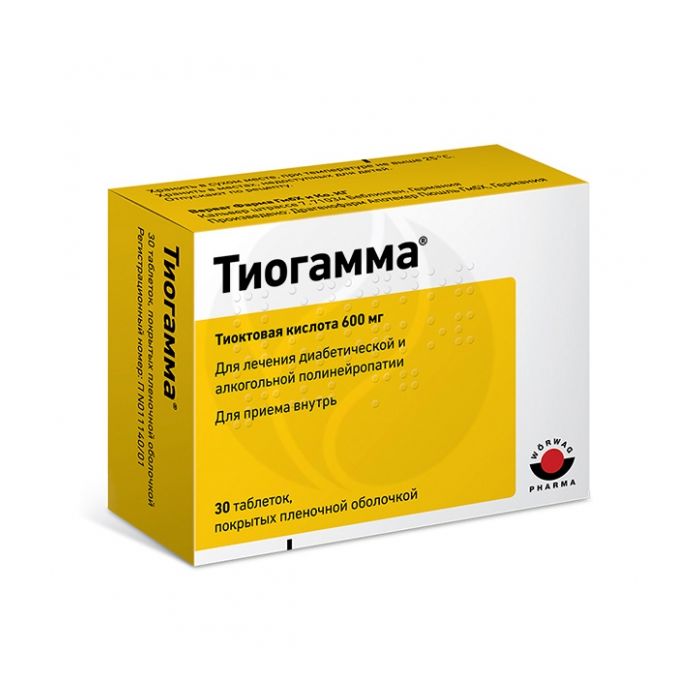Tiogamma tablets 600mg, No. 30
Russian Pharmacy name:
Тиогамма таблетки 600мг, №30
Assign inside 600 mg (1 tablet) of TiogammaЃ 1 time per day. The tablets are taken on an empty stomach, without chewing, with a small amount of liquid. The duration of the course of treatment is 30 - 60 days, depending on the severity of the disease. The course of treatment can be repeated 2-3 times a year.
Film-coated tablets, oblong, biconvex, with a smooth and slightly shiny surface, with one dividing line on both sides, yellow with possible splashes of white and dark yellow.
1 tab.
thioctic acid 600 mg
Excipients: hypromellose - 25 mg, colloidal silicon dioxide - 25 mg, microcrystalline cellulose (type PH112) - 49 mg, lactose monohydrate - 49 mg, croscarmellose sodium - 16 mg, talc - 36.364 mg, dimethicone - 3.636 mg, magnesium stearate - 16 mg.
Hypersensitivity to thioctic acid or other components of the drug.
Children under the age of 18.
Hereditary galactose intolerance, lactase deficiency or glucose-galactose malabsorption.
Pregnancy and the period of breastfeeding ..
Before taking the drug, be sure to consult your doctor.
Pharmacodynamics:
Thioctic acid is an endogenous antioxidant (binds free radicals). In the body, it is formed during the oxidative decarboxylation of alpha-keto acids. As a coenzyme of mitochondrial multienzyme complexes, it participates in the oxidative decarboxylation of pyruvic acid and alpha-keto acids. Promotes a decrease in blood glucose concentration and an increase in glycogen in the liver, as well as a decrease in insulin resistance. Participates in the regulation of lipid and carbohydrate metabolism, affects the metabolism of cholesterol, improves liver function, has a detoxifying effect in case of poisoning with salts of heavy metals and other intoxications. It has a hepatoprotective, hypolipidemic, hypocholesterolemic, hypoglycemic effect. Improves the trophism of neurons.In diabetes mellitus, thioctic acid reduces the formation of end products of glycation, improves endoneural blood flow, increases the content of glutathione to a physiological value, which, as a result, leads to an improvement in the functional state of peripheral nerve fibers in diabetic polyneuropathy.
Pharmacokinetics:
When taken orally, it is rapidly and completely absorbed in the gastrointestinal tract, simultaneous intake with food reduces absorption. Bioavailability - 30-60% due to the 'first pass' effect through the liver. The time to reach the maximum concentration (4 ?g / ml) is about 30 minutes. It is metabolized in the liver by side chain oxidation and conjugation. Thioctic acid and its metabolites are excreted by the kidneys (80-90%), in small amounts - unchanged. The half-life is 25 minutes.
Application during pregnancy and during breastfeeding:
The use of ThiogammaЃ during pregnancy and lactation is contraindicated. (See section 'Contraindications').
Side effects:
Very rarely (<1/10000), the following side effects develop: Disorders from the gastrointestinal tract (GIT): nausea, vomiting, abdominal pain, diarrhea. Immune system disorders: allergic reactions (up to the development of anaphylactic shock), skin rash, urticaria, itching; autoimmune insulin syndrome (AIS), clinical manifestations of AIS can be: dizziness, sweating, muscle tremors, heart palpitations, nausea, headache, confusion, visual impairment, loss of consciousness, coma. Disturbances from the nervous system: a change or violation of taste. Metabolic and nutritional disorders: due to improved absorption of glucose, a decrease in the concentration of glucose in the blood is possible. In this case, symptoms of hypoglycemia may occur - dizziness, increased sweating,headache, visual disturbances. Frequency not known (cannot be determined from the available data): Skin and subcutaneous disorders: eczema. If any of the side effects indicated in the instructions are aggravated, or you notice any other side effects that are not indicated in the instructions, inform your doctor.
Overdose:
Symptoms: nausea, vomiting, headache. In the case of taking doses from 10 to 40 g of thioctic acid in combination with alcohol, cases of intoxication were observed, up to and including death. Symptoms of acute overdose: psychomotor agitation or clouding of consciousness, usually followed by the development of generalized seizures and the formation of lactic acidosis. Cases of hypoglycemia, shock, rhabdomyolysis, hemolysis, disseminated intravascular coagulation, bone marrow depression, and multi-organ failure have also been described. Treatment is symptomatic. There is no specific antidote.
Interaction with other medicinal products:
Thioctic acid enhances the anti-inflammatory effect of glucocorticosteroid drugs. With the simultaneous appointment of thioctic acid and cisplatin, a decrease in the effectiveness of cisplatin is noted. Thioctic acid binds metals, therefore it should not be administered concurrently with drugs containing metals (for example, iron, magnesium, calcium preparations) - the interval between doses should be at least 2 hours.With the simultaneous use of thioctic acid and insulin or oral hypoglycemic drugs, their effect may intensify. Ethanol and its metabolites weaken the effect of thioctic acid.
Х If you are already taking other medications or are going to take them, be sure to consult your doctor before taking ThiogammaЃ.
special instructions
Patients with rare hereditary fructose intolerance, glucose-galactose malabsorption syndrome or glucose-isomaltose deficiency should not take ThiogammaЃ. In patients with diabetes mellitus, constant monitoring of the blood glucose concentration is necessary, especially at the initial stage of therapy. In some cases, it is necessary to reduce the dose of insulin or an oral hypoglycemic drug to avoid the development of hypoglycemia. With the development of hypoglycemia, you must immediately stop taking ThiogammaЃ. If symptoms of hypersensitivity appear, you should immediately stop taking ThiogammaЃ. Patients taking ThiogammaЃ should refrain from drinking alcohol. Alcohol consumption during therapy with ThiogammaЃ reduces the therapeutic effect and is a risk factor,contributing to the development and progression of neuropathy. 1 film-coated tablet of TiogammaЃ 600 mg contains less than 0.0041 bread units. Cases of the development of autoimmune insulin syndrome (AIS) during treatment with thioctic acid have been described. The possibility of AIS occurrence is determined by the presence of HLA-DRB1 * 04: 06 and HLA-DRB1 * 04: 03 alleles in patients.
Influence on the ability to drive vehicles and work with mechanisms: Taking the drug ThiogammaЃ does not affect the ability to drive vehicles and work with other mechanisms.

